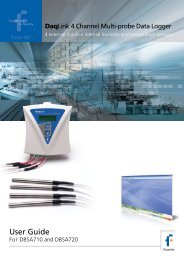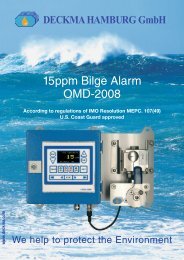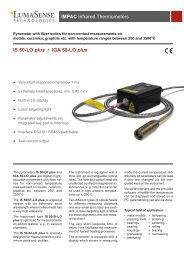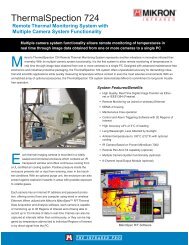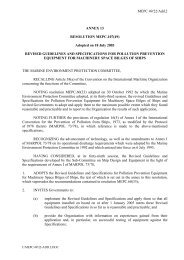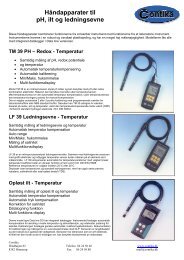Pyrometer- Handbook - Contika
Pyrometer- Handbook - Contika
Pyrometer- Handbook - Contika
You also want an ePaper? Increase the reach of your titles
YUMPU automatically turns print PDFs into web optimized ePapers that Google loves.
Spectral Intensity<br />
Visible light with all its colours, infrared radiation, x-rays<br />
or γ - rays (gamma), are similar in nature. Their differences<br />
lie in wavelength, or frequency. The wavelength is<br />
expressed as the "colour" of the light (see Illustration 4).<br />
One should consider the energy or the intensity of the<br />
radiation coming from the black body. Illustration 4 shows<br />
the relative distribution of heat radiation (spectral<br />
Spectral Intensity (relative)<br />
intensity) across the wavelengths. The exponential<br />
correlation of intensity and wavelength requires double<br />
logarithmic scaling for graphic representation.<br />
Illustration 4 demonstrates that the intensity curve moves<br />
left toward the shorter wavelength as the temperature rises.<br />
At temperatures over 550 °C the curve reaches the area of<br />
visible light. The object to be measured begins to glow. At<br />
higher temperatures the intensity rises in the visible area.<br />
Steel glows red hot at first, then, as the temperature rises,<br />
one speaks of white hot which means all spectral colours<br />
are represented.<br />
<strong>Pyrometer</strong> <strong>Handbook</strong><br />
6000°C<br />
Light<br />
3000°C<br />
1500°C<br />
500°C<br />
0°C<br />
Wavelength in µm<br />
Illustration 4:<br />
Distribution<br />
of Intensity<br />
13



